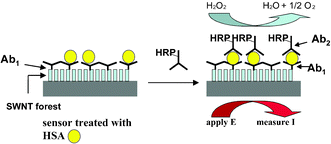Protein immunosensor using single-wall carbon nanotube forests with electrochemical detection of enzyme labels†
Abstract
Vertically aligned arrays of single-wall

* Corresponding authors
a
Department of Chemistry, 55 N. Eagleville Rd., University of Connecticut, Storrs, CT 06269-3060, USA
E-mail:
James.Rusling@uconn.edu
Fax: +860-486-2981
Tel: +860-486-4909
b
Nanomaterials Optoelectronics Laboratory, Institute of Material Science, University of Connecticut, Storrs, CT 06269-3136, USA
E-mail:
Papadim@mail.ims.uconn.edu
c Department of Pharmacology, University of Connecticut Health Center, Farmington, CT 06032, USA
Vertically aligned arrays of single-wall

 Please wait while we load your content...
Something went wrong. Try again?
Please wait while we load your content...
Something went wrong. Try again?
X. Yu, S. N. Kim, F. Papadimitrakopoulos and J. F. Rusling, Mol. BioSyst., 2005, 1, 70 DOI: 10.1039/B502124C
To request permission to reproduce material from this article, please go to the Copyright Clearance Center request page.
If you are an author contributing to an RSC publication, you do not need to request permission provided correct acknowledgement is given.
If you are the author of this article, you do not need to request permission to reproduce figures and diagrams provided correct acknowledgement is given. If you want to reproduce the whole article in a third-party publication (excluding your thesis/dissertation for which permission is not required) please go to the Copyright Clearance Center request page.
Read more about how to correctly acknowledge RSC content.
 Fetching data from CrossRef.
Fetching data from CrossRef.
This may take some time to load.
Loading related content
